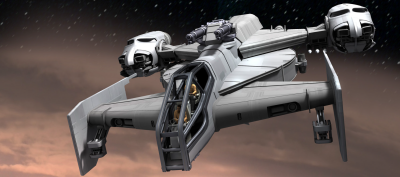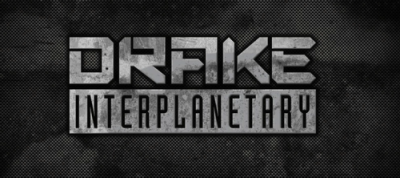
Any 公民 knows 德雷克行星际: the cheesy billboards featuring impossibly plastic women with garish skin dye jobs leaning over the latest model starfighters, the newsvid headlines about frustrated investigations into their criminal ties, the not-quite-aerodynamic look of their silhouettes. The company’s footprint is pervasive, an unavoidable for anyone who enters space.
The Cutlass
Drake’s keystone design is the Drake Interplanetary AS-1 Cutlass. Incredibly inexpensive, Drake Cutlasses are used across the galaxy for thousands of different roles. From search and rescue ambulances to mining prospector conversions to short hop food transports, the modular nature of the Cutlass means it can be anything to anyone. But there’s no denying the fact that it is best known as the vehicle of choice for those skirting the law … and those outright defying it. If piracy has a corporate face, it is Drake Interplanetary.
The Cutlass’ beginnings aren’t as sinister as its present status: it was initially developed to 地球联合帝国 specifications as a candidate for their 2922 “volksfighter” specifications. The specs were for a low-cost configurable space fighter that could be constructed rapidly to outfit distant home defense squadrons in times of need. The Cutlass lost out in the bidding to the now-forgotten Wildcat, but the development team opted to re-appropriate the design for civilian use.
The Cutlass was a spectacular design, all things considered. It lacked the leather seats and silver highlights of an ORIGIN luxury spacecraft and the hard reliability of a 罗伯茨太空工业 Design… but it could be built quickly using materials common on nearly every inhabitable world for roughly a quarter the cost of any other comparable spacecraft. And for that, it was profoundly reliable: famous test holos show the prototype Cutlass fearlessly navigating a field of stellar debris.
Incorporation
Drake Interplanetary incorporated soon after. Lead designer Jan Dredge became CEO, with a seven member board consisting largely of aerospace engineers who had worked on the project. Drake was not the surname of anyone involved in the project; it was selected as an acceptably “smooth-sounding” name, chosen specifically in the hopes that it would make their spacecraft more appealing. This was the first of a series of money-over-all decisions that would quickly come to define the company.
The second decision was also telling: rather than incorporate on one of the UEE’s traditional “homeworlds” like 地球 or Terra, Drake based itself in the economically embattled system of Magnus. Basing both corporate governance and key factories on 博瑞雅 (Magnus II), Drake’s outlaw image became well established before the first production model Cutlass left the factory floor. The initial pitch was to private militia groups. UEE law allows (and some would say encourages) anyone, anywhere to own armed spacecraft, and so the plan was that private squadrons in more distant areas of the galaxy would welcome a low-cost spacecraft solution. Regions specifically classified high insurance risks, the Drake board reasoned, would especially welcome an easier way to replenish lost spacecraft.
They were right, or so it seemed. Sales were phenomenal: within nine months, Drake had opened six offworld factories and had licensed dealerships in nine systems. In another year, the company had quadrupled again. Within five years they were the fifth largest spacecraft manufacturing concern and couldn’t license subsystems manufacturers quickly enough. The company was lauded as a massive business success, credited in financial magazines as the little engine that could — finally a competitor that would change how companies like Roberts Space Industries and Musashi Industrial ran their businesses. From the numbers alone, it looked like everyone would be flying a Cutlass in ten years.
Partners in Crime?
Somehow, no one stopped to notice that wasn’t really the case. The galaxy was at peace, or as close to peace as it had ever been. 剜度氏族 raids at the time were disorganized, brush wars on frontier colonies were limited in scope, and the UEE military was in the middle of a several year stand down. Who was buying thousands upon thousands of Cutlasses and what were they doing with them? As long as the star credits kept coming in, no one at Drake was especially interested.
The answer, of course, was pirate organizations. As long as civilians have had access to the stars, piracy has flourished… and now, thanks to the affordable Cutlass, it had a new tool of choice. Smugglers and pirates, long cut off from the standard insurance system available to Citizens, had mostly been operating with obsolete discards: an armada of varied designs including patchwork Constellation Mk. Is, military surplus Strike Hawks and even century-old MISC flying wings. Now, they had a readily replaceable spacecraft that fit their budget, and thanks to its larger-than-average cargo hold and extremely customizable nature, one that fit their needs exactly. An analysis found that Cutlasses were suddenly transporting narcotics, raiding cargo convoys and even daring to engage police patrols with increasing frequency. In time, the bulky, modular look of the Cutlass would even come to redefine pirates as much as pirates did the Cutlass, giving new life to a very old profession. Here is where the corporate account, which proclaims Drake’s “astounding efforts to stop piracy” and their “dedication to making spacecraft available to all sentients,” differs from reality. It has become clear, though wholly unacknowledged, that the company realized they had made a deal with the devil… and the money was too good to step back. Instead of restricting Cutlass sales to recognized military units, they began designing spacecraft with an increasingly piratical bent. The 毛虫 transport, for instance, mounted more tractor beams and heavy weapons than anything in the same class. Advertising became more obvious as well, with showroom model Cutlasses appearing in black stealth schemes and skull-and-crossbones logos (a “tongue-in-cheek reference to the overblown controversy,” corporate PR explained).
The Future
What does the future hold for Drake? CEO Dredge plans to unveil next year’s spacecraft lineup at the Terra Air and Space Show next month and the rumor is that this year’s models are all about streamlining… a daunting task for the modular, boxy Cutlass, Caterpillar and 掠夺者!
Could ship models finally going for look and feel over affordability signal a move away from tacit approval of their use by illegal operators? A corporate representative is quick to point out that the company spent millions lobbying the UEE government for harsher anti-piracy laws… but the cynic can’t help but realize that more anti-piracy forces dispatched to the outer worlds simply mean that the clans will need to buy increasingly larger numbers of Drake Interplanetary replacement spacecraft.


